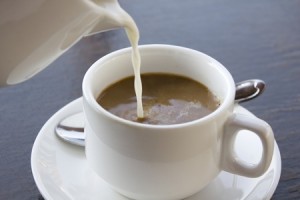
Can coffee drinkers, especially of café au lait, espresso, mochachino variety be really divided into groups or do we just drink what we fancy at random ? If like most Americans, we tend to see coffee drinking as a way to ‘get us started’ especially in the morning, tackling what life a busy day has to offer and using a legal fix in caffeine. Those of us who view coffee as a means of relaxation, of socialising, meeting friends and discussing political and world events as our forebears did in the coffee houses of yesterday must wonder what has happened to coffee.
We are confronted with a plethora of drinking experiences, from the small, perfectly formed pool of extremely strong, almost smoky and oily black coffee shot to a frothy, creamy extravaganza served like a sundae. Most baristas in Europe for example only have to deal with the basic essentials – the latte, cappuccino, espresso and café au lait. Its perhaps the way you enjoy coffee in a European climate that matters rather than gulping it down before making that taxi or train stop.
What Started the Café Au Lait Phenomenon ?
The café au lait as its origins suggest, is a very French concoction – not Italian or American. It may still be milky coffee or as literally translated, ‘coffee with milk’ but it forms a mainstay of breakfast coffee culture. Views of the Eiffel Tower in Paris or overlooking a fashionable dress boutique in some ‘rue’ make this coffee irresistible. The key is not just the hot milk – remember cold milk just cools down a coffee too quickly but the way it is then presented. In France, bowls are ‘derigeur’.

Generally, a café au lait is prepared using espresso from a coffee machine and steamed milk. These entered service just after the Second World War and have been a mainstay ever since.
If you are being more aggressive, more dynamic, than the Italian ‘espresso’ is your thing. Imagine, sitting in the Trasvetere area of Rome at an outdoor breakfast table. Espresso coffee lends itself well to the hustle and bustle of the throng, with small scooters and incredibly dapper, well-dressed Romans completing the scene.
Milky Coffee In Other Parts Of The World
I’m aware that in other parts of Europe, different forms of café au lait exist. The Dutch enjoy something called ‘incorrect coffee’ (koffie verkeerd), in Germany, a milky coffee called ‘Milchkaffee’ and in Poland, kawa biała. I rather enjoyed the Spanish variant when I visited some of my friends in Madrid. Here they offer ‘café con leche’ which relies on a strong South American coffee bean to deliver a punch, only offset in bitterness by the addition of a very rich milk. Have you ever tried coffee with buffalo milk ? Not a strong contender but one which is commonly available in Bulgaria and Hungary.
It was some time afterwards, coming back to the USA, to Eugene in fact, that I realised we Americans may be losing some of the art of coffee drinking even though the American North-West is home of some fantastic caffeine brands. Here we find an American version of café au lait which is prepared using a French press or a drip brew system. Again, steamed milk is poured in but unlike its caffè latte cousin, requires espresso style coffee for its basis. The American style is to serve the coffee in a cup as opposed to the French style of using a fancy bowl. I have found a number of trendy establishments now adopting the Continental style to emphasise their across the pond credentials.
If we travel way down South to Louisiana or more specifically New Orleans, we see a café au lait prepared with scalded milk which is simply milk taken to just below boiling point. This makes for a creamier taste. There may also be chicory root in this coffee because it is a viable substitute. Incidentally, we learnt at school that chicory root powder was used as a substitute during the American Civil War when the Union blocked the port in New Orleans. More sugar is needed to overcome the slightly extra bitterness afforded by the chicory root.
Whatever your take on coffee, the café au lait is part of our heritage.
Written by Gus Friedman, Eugene, Oregon. USA for FoodWrite.
Please note this page contains links to our affiliate marketing partner. Please read our affiliate disclosure.


Take a look at this web-site as they seem to have a fair bit of knowledge about coffee generally. (http://coffee.wikia.com/wiki/Caf%C3%A9_au_lait). I agree – I prefer cappuccino.